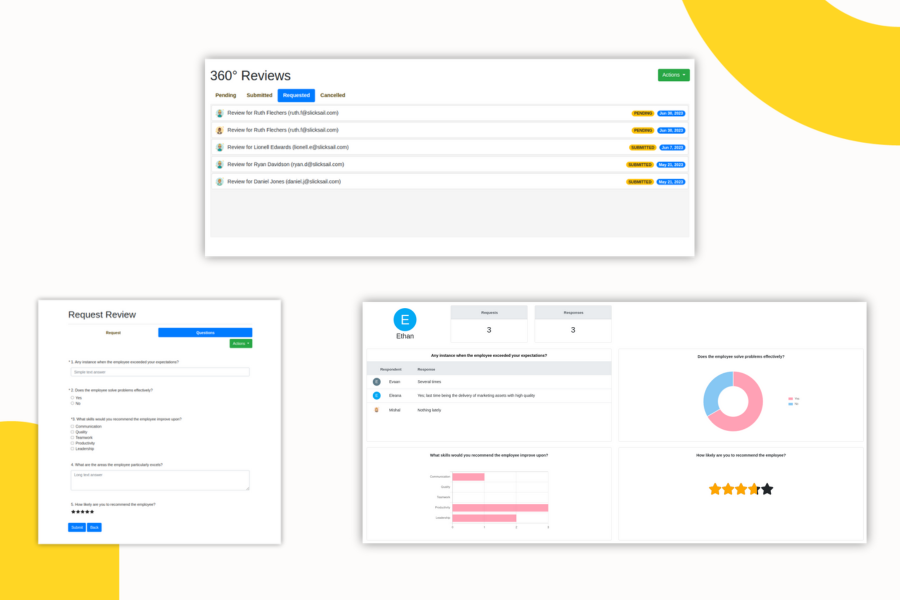Getting the Full Picture: A Guide to 360° Reviews
Traditional performance reviews fall short, offering just one viewpoint on employees’ contributions and capabilities. This leaves gaping blindspots on how employees are truly performing and leading. For a multi-dimensional perspective, more and more forward-thinking organizations are now embracing 360° reviews to get the full picture. Unlike standard annual reviews, 360° reviews gather insights from all key stakeholders that work closely with the employee.
What are 360° Reviews?
First things first: what are 360° reviews? Simply put, 360° reviews (a.k.a. multi-rater reviews) are an agile or continuous performance management tool used by leaders to understand the strengths and weaknesses of their employees by gathering anonymous feedback from multiple sources. This may include their peers, direct reports, and potentially external stakeholders like customers. The idea is to get a well-rounded view of someone’s strengths and areas for improvement, rather than relying on just one perspective. Feedback is usually collected by means of a questionnaire that assesses various aspects of an employee’s capabilities, such as communication skills, problem-solving abilities, leadership qualities, and adaptability.
You may wonder if 360° reviews aren’t similar to annual reviews. Firstly, 360° reviews purposefully collect perceptions from an employee’s complete circle of influence. Rather than just manager assessments, they gather insights horizontally from peers who experience behaviors firsthand. And by including critical third parties and even external inputs, they counter systemic biases while exposing blindspots. This multidimensional process delivers a more accurate picture of strengths and high-impact growth areas than any seasoned leader could provide on their own!
Secondly and more importantly, the end goal of 360° reviews is employee development, not performance appraisal. Since employees are reviewed for their capabilities and not based on their performance goals, it is illogical to use 360° reviews for making compensation decisions.
Benefits of 360° Reviews
360° reviews offer several advantages over traditional performance reviews—for employees, managers, and the organization as a whole. The combination of soliciting more feedback sources and shifting focus to employee development makes 360° reviews incredibly valuable to optimizing people management.

Benefits for employees:
Though an employee being reviewed is oblivious to the actual 360° review, it ultimately benefits him/her as it offers visibility into strengths, growth areas, and how one’s work is perceived—unlocking greater self-awareness. This allows employees to view their own impact through the eyes of their colleagues. With the help of the manager, employees can work on improving their weaknesses alongside their strengths, knowing that the inputs are not biased and not the manager’s own.
Benefits for managers:
Compared to managers’ limited point of view, 360° reviews help identify skill gaps, gain a fuller understanding of employees, supplement subjective judgment with additional data, and enable early action on emerging issues raised by the team itself. They also help tailor development plans for their team members based on common feedback themes.
Benefits for the organization:
With 360° reviews in place, development programs become far better targeted to real rather than perceived needs. By increasing sources, 360° reviews balance out individual biases that hinder organizational growth. Other potential benefits include increased employee retention, the promotion of a continuous feedback culture, and the surfacing of cross-collaboration issues.
The wealth of mutually reinforcing benefits makes implementing 360° reviews well worth the effort for most organizations. The outcome? More confident, invested, and high-performing teams.
The 360° Review Process
The 360° review process is quite easy and straight-forward to implement. It typically involves the following steps:

- Choose reviewers: Identify colleagues who regularly interact with the employee to be reviewed so as to get balanced insights.
- Create questionnaire: Develop standard questions assessing capabilities like leadership, communication, and problem-solving.
- Collect responses: Have reviewers complete the questionnaire anonymously to enable candid responses.
- Analyze results: Aggregate responses to identify strengths and areas for improvement.
- Develop an action plan: Create an employee development plan to build on strengths and address constructive growth opportunities.

Best Practices
Adopting 360° reviews can be challenging at first, especially for managers. But the transparency and clarity 360° reviews provide leads to tremendous organizational, team, and individual benefits that vastly outweigh temporary discomforts. Following are some practical tips to get things off the ground.
- Start small: Begin with a pilot program involving a few employees to test the process and identify potential pitfalls.
- Educate employees: Offer training for both managers and employees to ensure they understand how to request and respond to reviews effectively.
- Choose the right reviewers: Select reviewers who know the employee’s work well and are willing to give candid feedback.
- Choose the right software: Utilize software that simplifies the process and provides analytics and reporting capabilities.
- Use a consistent questionnaire: Utilize a standardized questionnaire to ensure consistency across all employees and ease of comparison.
- Focus on development: Position 360° reviews as growth tools, not justification for compensation decisions.
- Monitor progress: Track employee progress over time to measure the effectiveness of the 360° review program.
360° reviews are a valuable tool for providing actionable insights for employee development. While acknowledging the inherent limitations of any human-driven process, the benefits of improved performance, enhanced self-awareness, and better decision-making make them a worthwhile investment for organizations committed to developing their human capital. By following best practices and deploying a well-structured 360° review process, facilitated by platforms like Peptrics, organizations can unlock the potential of a more engaged, productive, and successful workforce.
